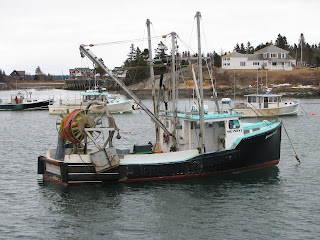 AP photo by Robert F. Bukaty
AP photo by Robert F. BukatyFor anyone who has read previous media stories about RawFaith, today's sinking of the vessel off Nantucket will be recognized as the final chapter of the ship's tortuous history. If any vessel seemed doomed, this was the one - despite the determined optimism of its amateur builder and captain, George McKay.
McKay, initially with his family's help, built the 100-foot galleon on the shore of the Pleasant River in Addison with the goal of providing sailing experiences to wheelchair-bound children. Early media stories (like this one) focused on McKay's vision and devotion to the cause and on the boat's striking appearance.
But interest in the ship took a turn soon after the boat was floated into the water. The ship nearly sank on its maiden voyage in 2004, and two years later it again was seriously damaged at sea. It became a polarizing topic between some who admired McKay's dedication and others who felt the ship wasn't seaworthy and that McKay posed a threat to others who might sail away with him on the rickety vessel. The ship sat in Rockland and then in Portland as McKay dealt with occasional Coast Guard dictums about making improvements and also tried to raise funds for its repairs and operation.
Meanwhile, online yachting forums (such as this one) buzzed with criticism about McKay's seeming folly. Subsequent media coverage (for example) focused on how McKay was determined to press ahead regardless of the mounting criticism of the execution of his idea.
And such was the situation this past spring when Chris Busby of the Bollard wrote this incisive and prescient article on McKay's struggles over the past decade to bring the project to fruition. Busby's piece cuts to the bone, laying bare McKay's pain at seeing his daughter struggle with disease, first for survival and then acceptance; his unexpected inspiration to the build the boat; and the adversity he has faced in trying to make the ship and its mission a reality.
I cannot recount the bitter tale of RawFaith half as well as Busby does. The clear implication of the story and others like it is that, aside from his daughter's illness, McKay has brought many of his problems upon himself by failing to recognize that all the inspiration in the world sometimes cannot be a substitute for actual expertise and a practical outlook.
The only worse ending imaginable would be if RawFaith had taken McKay or anyone else down with her. If there is any evidence that the divine may have played a role in this saga, it could be that, amazingly, no one was seriously physically hurt as McKay tried to make his admirable but ultimately hopeless vision a reality.





































